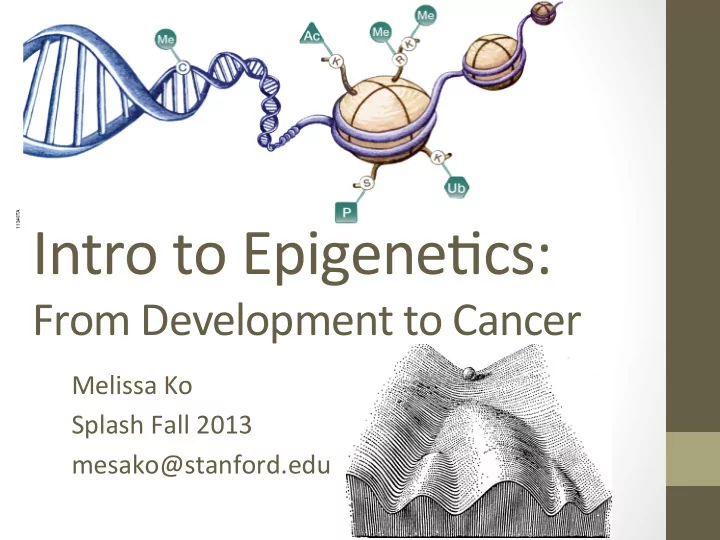

Intro ¡to ¡Epigene,cs: ¡ From ¡Development ¡to ¡Cancer ¡ Melissa ¡Ko ¡ Splash ¡Fall ¡2013 ¡ mesako@stanford.edu ¡
Today’s ¡Class ¡Agenda: ¡ • What ¡is ¡ epigene&cs ? ¡ • How ¡is ¡informa,on ¡conveyed ¡in ¡cells? ¡ • Overview ¡of ¡chroma,n ¡structure ¡regula,on ¡ • How ¡does ¡epigene,cs ¡mediate ¡development? ¡ • What ¡role ¡does ¡ epigene&cs ¡play ¡in ¡ cancer ? ¡ • DNA ¡hypermethyla,on ¡ • EZH2 ¡histone ¡methyltransferase ¡muta,ons ¡ • SWI/SNF ¡chroma,n ¡remodeler ¡muta,ons ¡
What ¡is ¡ epigene&cs ? ¡
Biological ¡informa,on ¡is ¡stored ¡ in ¡our ¡DNA ¡sequence ¡in ¡cells. ¡
Biological ¡informa,on ¡is ¡stored ¡ in ¡our ¡DNA ¡sequence ¡in ¡cells. ¡ • produces ¡ RNA ¡transcripts ¡that ¡act ¡as ¡instruc,ons ¡ for ¡building ¡a ¡diversity ¡of ¡func,onal ¡ proteins ¡
However, ¡this ¡cannot ¡be ¡the ¡ only ¡form ¡of ¡informa,on ¡in ¡cells. ¡ • many ¡ cell ¡types ¡ are ¡found ¡in ¡the ¡ human ¡body ¡ • fulfill ¡ different ¡ func&ons , ¡but ¡ have ¡essen,ally ¡ the ¡ same ¡DNA ¡
Biological ¡info ¡is ¡conveyed ¡by ¡ the ¡state ¡of ¡DNA/chroma,n. ¡ • informa,on ¡is ¡ embedded ¡in ¡ structure ¡of ¡DNA ¡ besides ¡sequence ¡ ¡ • chroma&n ¡can ¡have ¡ a ¡certain ¡structure ¡ in ¡one ¡cells, ¡and ¡a ¡ different ¡one ¡in ¡ another ¡cell ¡
Chroma,n ¡structural ¡changes ¡ make ¡up ¡epigene,c ¡informa,on. ¡ • Epigene,cs ¡are: ¡ • non-‑gene,c ¡cellular ¡ memory/info ¡ • heritable ¡and ¡usually ¡self-‑ perpetua,ng ¡ • responsive ¡to ¡inputs ¡and ¡ reversible ¡ • Epigene,cs ¡lead ¡to: ¡ • changes ¡in ¡ gene ¡expression ¡ • changes ¡in ¡cell ¡behavior ¡or ¡iden,ty ¡ ( phenotype ) ¡
DNA ¡itself ¡can ¡be ¡modified ¡by ¡ methyla,on ¡at ¡cytosine ¡bases. ¡ • methyl ¡(CH 3 ) ¡ groups ¡added ¡at ¡ cytosine ¡next ¡to ¡ guanine ¡(CpG) ¡ • larger ¡stretches ¡of ¡ CpG ¡found ¡near ¡ promoters ¡ ( islands ) ¡ • repressive ¡mark ¡
DNA ¡associates ¡with ¡proteins ¡ (histones) ¡to ¡form ¡chroma,n. ¡ DNA ¡strands ¡ histone ¡core ¡
Combina,ons ¡of ¡histones ¡make ¡a ¡ “spool” ¡for ¡DNA ¡to ¡wind ¡around. ¡ • each ¡protein ¡(H3, ¡etc.) ¡is ¡encoded ¡by ¡its ¡own ¡gene ¡
Chroma,n ¡has ¡ many ¡levels ¡of ¡ structure ¡and ¡ compac,on. ¡ • DNA ¡molecules, ¡ unwound, ¡would ¡have ¡a ¡ length ¡on ¡the ¡order ¡of ¡ meters ! ¡ • cells ¡are ¡very ¡small, ¡so ¡ coiling ¡is ¡necessary ¡
Histones ¡can ¡be ¡ chemically ¡ modified ¡on ¡tails ¡ exposed ¡outside ¡ the ¡inner ¡DNA-‑ protein ¡core. ¡ • small ¡tags ¡ added ¡covalently ¡on ¡ mainly ¡lysine ¡residues ¡ • these ¡marks ¡are ¡ accessible/ readable ¡on ¡the ¡outside ¡
Histone ¡modifica,ons ¡work ¡ through ¡three ¡enzyme ¡classes. ¡ interprets ¡marks ¡ removes ¡marks ¡ makes ¡marks ¡
Different ¡modifica,ons ¡convey ¡ different ¡biological ¡meaning. ¡
Nucleosome ¡posi,oning ¡is ¡ dynamic, ¡affec,ng ¡accessibility. ¡ • allows ¡for ¡gene ¡expression , ¡by ¡giving ¡RNA ¡ polymerase ¡(and ¡other ¡proteins) ¡access ¡
Epigene,c ¡marks ¡work ¡together ¡ to ¡change ¡chroma,n ¡structure. ¡ • one ¡mark ¡can ¡cause ¡chroma,n ¡to ¡gain ¡another ¡ • repressive ¡or ¡ac,va,ng ¡marks ¡can ¡ cooperate ¡
End ¡result: ¡epigene,cs ¡changes ¡ which ¡genes ¡are ¡expressed. ¡
Epigene,cs ¡“program” ¡cells ¡to ¡ follow ¡certain ¡instruc,ons. ¡ • a ¡muscle ¡cell ¡will ¡ follow ¡muscle ¡cell ¡ instruc&ons ¡and ¡make ¡ muscle ¡proteins, ¡but ¡a ¡ neuron ¡or ¡a ¡skin ¡cell ¡ will ¡not ¡ • differences ¡arise ¡in ¡the ¡ epigene&cs , ¡chroma,n ¡ configura,on, ¡ not ¡DNA ¡
Epigene,c ¡landscape ¡shows ¡cells ¡ falling ¡into ¡different ¡lineages. ¡
Epigene,c ¡landscape ¡shows ¡cells ¡ falling ¡into ¡different ¡lineages. ¡
Inputs ¡influence ¡epigene,cs ¡and ¡ cause ¡cells ¡to ¡differen,ate. ¡
Differen,ated ¡cells ¡have ¡marks ¡ to ¡turn ¡on ¡type-‑specific ¡genes ¡ and ¡turn ¡off ¡unrelated ¡genes. ¡
Epigene,cs ¡plays ¡a ¡major ¡role ¡in ¡ development ¡as ¡cells ¡take ¡on ¡roles. ¡
What ¡role ¡does ¡ epigene&cs ¡ play ¡in ¡ cancer ? ¡ ¡
Model ¡of ¡cancer ¡has ¡long ¡focused ¡ on ¡gene,c ¡changes ¡from ¡normal. ¡
But ¡cancer ¡also ¡results ¡from ¡non-‑ gene,c ¡gene ¡expression ¡changes. ¡
Evidence ¡has ¡been ¡found ¡of ¡ epigene,c ¡ac,vators ¡at ¡oncogenes ¡ and ¡repressors ¡at ¡TSGs. ¡
DNA ¡hypermethyla,on ¡at ¡TSGs ¡ leads ¡to ¡cancer ¡ini,a,on. ¡ inac,va,on ¡of ¡ tumor ¡ suppressor ¡genes ¡
EZH2 ¡muta,ons ¡causes ¡aberrant ¡ widespread ¡histone ¡methyla,on. ¡
SWI/SNF ¡complex ¡moves ¡ nucleosomes ¡to ¡shape ¡chroma,n. ¡
Loss ¡of ¡SWI/SNF ¡complex ¡means ¡a ¡ loss ¡of ¡repression ¡of ¡oncogenes. ¡
Epigene,c ¡drugs ¡are ¡being ¡ explored ¡as ¡a ¡new ¡cancer ¡therapy. ¡
Any ¡Ques,ons? ¡ • feel ¡free ¡to ¡email ¡me ¡at ¡mesako@stanford.edu ¡
Recommend
More recommend